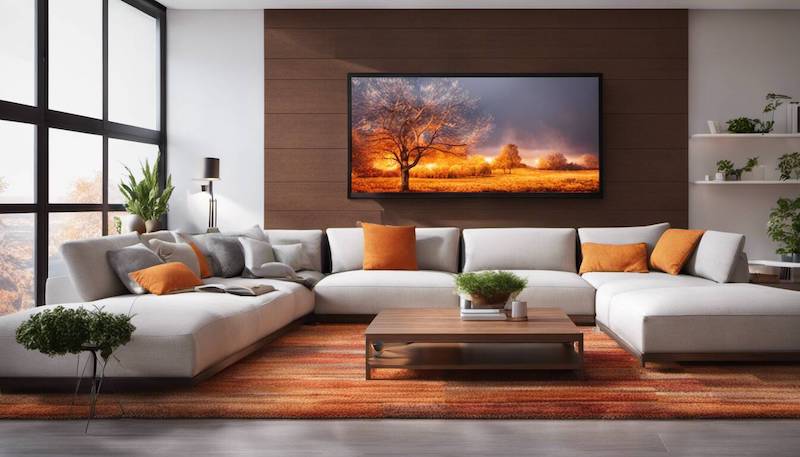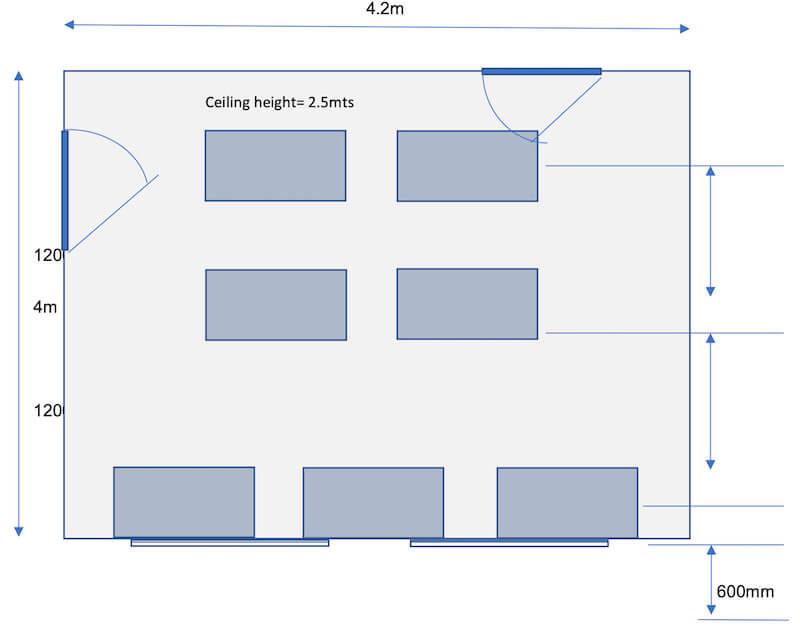Unveiling the full potential of your infrared heating system entails a comprehensive exploration of its heating capacity, with a particular focus on its relationship to the coverage area. In this article, we immerse ourselves in the intricacies of calculating coverage area, shedding light on the foundational principles of infrared heating.
Our journey extends beyond mere guidance on selecting the right system; it delves into what infrared heating is, the step-by-step process of determining the required heating power and the number of heating units used to achieve comfort! As we navigate this landscape, we also consider the diverse range of temperatures, explore the broad spectrum of infrared wavelengths, and analyse the consequential changes in the heating dynamic.
Table of Contents
Understanding Infrared Heating Principles
Selecting the Right Infrared Heating System
Calculating the Heating Power Required
Calculating The Required Number of PowerBoard Panels
Placement Guidelines for Optimal Thermal Performance
Mastering Infrared Heating Efficiency

- Thermal transmittance (aka U Value): Understanding how heat moves throughout a building is vital, and this is quantified by the Thermal Transmittance, commonly known as the U Value. This value plays a crucial role in understanding how heat moves through a building. In the context of calculating the heating load for a home, it’s important to note that the U Value doesn’t directly determine the coverage area for an effective heating strategy. Instead, a house’s cumulative building envelope has a set amount of U values, which equates to the number of heating panels required.
- Determining the number of heaters required: Once the power output of each heater is established, the article delves into the intricacies of calculating the total energy required to warm the room’s volume. This calculated energy value serves as the cornerstone for deciding the optimal number of heaters needed to achieve efficient and comfortable heating.
- Heater Placement and Distance: Logical placement of heaters is a crucial consideration. Rather than clustering them closely together, the article emphasises the strategic spacing of heaters to ensure maximal heat displacement. The goal is to offer insights that optimise their effectiveness, promoting even heat distribution throughout the entire space.
Understanding Infrared Heating Principles
When it comes to efficient and effective heating solutions, understanding the principles of infrared heating is important. Unlike traditional heating systems that rely on convection or forced air to warm a space, infrared heating systems utilise electromagnetic radiation to transfer heat directly to objects and individuals within the room.
To grasp this concept, think of how the sun warms your skin on a cold sunny day. The sun emits infrared radiation which travels through the air and heats up objects it comes into contact with – including us. Infrared heating systems work on a similar principle, emitting infrared thermal radiation at a certain wavelength that warms objects in its path. This method of heating is not only energy-efficient but also provides consistent and comfortable warmth without excessively drying out the air or stirring up dust particles like forced-air systems do.
Did you know?
A 800W IR heating system installed in an 8m2 room can increase a room’s temperature to 18°C in 10 mins, while other heating systems (2000W convection heater and 1560W storage heater) took 15 and 17 minutes respectively. [R]
For instance, imagine you’re sitting in a chilly room with an infrared heating system installed on the ceiling. As the ceiling warms up, it emits invisible light waves that travel directly downwards. When these waves come into contact with your body or objects around you, they are absorbed and converted into heat. This direct transfer of heat eliminates any loss typically associated with traditional heating methods, resulting in maximum efficiency.
Selecting the Right Infrared Heating System: Factors to Consider
So are infrared heaters cost-effective and can external factors impact the efficacy for this units?
There are several factors to consider. By taking these into account, you can ensure that you choose an infrared heater that will effectively and efficiently meet your heating requirements.
Firstly, you need to evaluate the size and layout of the area you wish to heat. Infrared heating systems are available in various sizes and heating capacities, so it’s important to select one that matches your space appropriately. Consider factors such as ceiling height, insulation, room area, and ventilation.
Next, think about the intended use of the space. Are you looking to heat a small office or a large workshop? Different infrared heating systems are designed for different applications, so understanding your specific needs will help guide your decision-making process.
Additionally, safety considerations are paramount. For instance, if you plan to use the heater in a commercial setting where people may be working close to it, it’s important to choose a system that doesn’t reach too high a surface temperature for safety reasons.
Did you know?
Conventional infrared heaters typically operate at temperatures between 90°C and 110°C, often leading to the discomfort of a ‘hot head, cold feet’ sensation. In contrast, our innovative PowerBoard panel is engineered to provide efficient heating at a lower and more comfortable temperature of 55°C. This not only ensures safety in both residential and commercial environments but also allows seamless integration by embedding the panels within walls and ceilings, which can then be plastered over. The lower temperature is gentle on plaster and paint, offering you an invisible yet effective source of warmth.
Calculating the Heating Power Required [A Real Life Example]
Achieving the desired heating outcome demands precision in determining the required quantity of panels. Guidelines based on house age, thermal transmittance, and power density calculations help in selecting the appropriate panels for the job.
Here’s a real-life example demonstrating the step-by-step process for installing our PowerBoard product in a given room.
Step 1: To determine the heating load (aka w/m2 or 2/m3 in spaces with room heights exceeding 3.5Meters), we use the following general guidelines.
| House kwh/m2*a Value | W/m2 or W/m3 requirement |
| 100kwh/m2*a | 90w/m2 or 35w/m3 |
| 70kwh/m2*a | 68w/m2 or 30w/m3 |
| 45kwh/m2*a | 40w/m2 or 25w/m3 |
Step 2: We have 2 types of PowerBoard IR panels, and below is how we determine which outputs to use!
| House kwh/m2*a Value | PowerBoard Heater Type |
| 100kwh/m2*a | Powerboard PB-S-250W |
| 70kwh/m2*a | Powerboard PB-S-250W |
| 45kwh/m2*a | Powerboard PB-S-180W and/or PB-S-250W |
Calculating The Required Number of PowerBoard Panels
Step 3: Now that we’ve determined the panel type and thermal transmittance, it is time to consider the quantities required in order to create comfort heating within your environment. This can be done by following these steps:
- Begin by assessing the ceiling area. For flat ceilings, consider measuring the floor (a quicker means of estimation).
- Determine the square meterage (m2) by multiplying the room’s width by its length. For example, a room measuring 4 metres by 5.2 metres results in a total area of 20.8m2.
- Measure the ceiling height, denoted as h, which, for instance, could be 2.5 metres.
- Calculate the room volume using the formula: Volume = Area x Height. For our example, the volume would be 20.8m2 x 2.5m = 52m3.
- Select the appropriate power density based on the house age or by using the relevant U-Value to determine the heating load requirement. For a house built in 2001, the power density might be 25 watts per cubic metre (W/m3).
- Calculate the total power required by multiplying the room volume by the chosen power density. In our case, it would be 52m3 x 25W/m3 = 1300 watts.
- Finally, determine the quantity of PowerBoard panels needed. Assuming a house built in 2001, opt for Powerboard PB-S-180W due to its superior insulative properties.
Thus, the required number of boards required = 1300/180 = 7.22*
*Round up to ensure adequate heat load!
Therefore, 8 PowerBoard-180W are required.
Other Factors That May Influence Heat Coverage Calculations
Surface Area to Volume Ratio of Space
Relative Outside Temperature
With all things being equal, if the lowest outside temperature in one place is lower than in another place, then more heating coverage is needed!
Exposure to Wind / Chill Factor
Exposure to wind impacts the amount of heating needed. Depending on where the house is situated – whether it’s sheltered or exposed, or if it’s on a higher or lower level in a building – more heating coverage may be necessary to compensate for heat loss caused by wind chill. Think of scenarios like having a house on a windy hill, near the ocean, or in a high-rise building in London.
Placement Guidelines for Optimal Thermal Performance
Ensuring the highest level of thermal efficiency involves adherence to placement guidelines. Whether calculating heating load based on floor area or total volume, striving for even distribution, or considering heat losses and surroundings, these guidelines provide a blueprint for maximising the effectiveness of PowerBoard heaters. Practical constraints may arise, but these guidelines offer flexibility while maintaining efficiency.
- Calculate the appropriate heating load based on either floor area or total volume, depending on the ceiling height. For ceilings below 3 metres, use volume; for ceilings above 3 metres, use area.
- When positioning PowerBoard heaters within a room or building, strive for even distribution to achieve the most effective heating.
- Consider the heat losses of surrounding surfaces when placing PowerBoard heaters. It is advisable to position more heat-emitting surfaces near facades and windows to cover heat losses and mitigate potential draughts. However, avoid placing radiative solutions directly opposite windows, as this diminishes heating effectiveness.
The following instructions outline the theoretically ideal placement of PowerBoard. However, practical constraints such as ceiling beams, lights, or other installations may impede this ideal placement. Additionally, cost considerations may lead to a simplified distribution of heating panels, resulting in some reduction in heating effectiveness
- Position the first panel near the outer wall, closest to the window, and place the PowerBoard 600mm from the wall.
- Space subsequent panels 1.2 metres apart (measured from the centre) across the ceiling width.
- Distribute PowerBoard-S heaters evenly along the ceiling length. For a visual representation, take a look at the illustration below.
- Exercise caution not to install any boards facing obstructing surfaces, such as slanted walls or suspended fixtures like chandeliers, as this can impede heating effectiveness.
Illustrative Visual Example of Infrared Ceiling Layout

Mastering Infrared Heating Efficiency
In conclusion, achieving optimal efficiency in your infrared heating system demands a holistic approach that extends beyond the basics. It’s not just about comprehending the principles or selecting the right system; it’s a comprehensive journey that involves understanding the electromagnetic spectrum, the intricate processes of emission, and the dynamics of heat transfer through conduction.
The efficiency journey encompasses more than just providing warmth; it involves creating a comfortable environment for people within designated areas. This requires a meticulous understanding of how different materials interact within the electromagnetic spectrum, influencing absorption rates and emission characteristics. Aligning the system with specific applications, whether for residential or commercial use, allows you to leverage the full potential of infrared heating for maximum efficiency.
Calculating heating power becomes a strategic process, considering not only the thermal needs of the space but also focusing on energy-saving aspects. Adhering to optimal placement guidelines goes beyond aesthetics; it’s about strategically positioning heating elements to optimise heat transfer and distribution. The source of infrared radiation, be it a specialised heating panel or a ceiling-mounted unit, plays a pivotal role in overall system efficiency.
In essence, mastering infrared heating efficiency involves navigating a landscape of interconnected elements, where the principles of the electromagnetic spectrum, emission processes, conduction-based heat transfer, and thoughtful application converge. By following the recommended steps outlined in this guide, you don’t just heat; you heat smartly, fostering a harmonious balance between comfort, energy savings, and the practicalities of various heating processes.
Q1. Where can I find resources for determining the suitable number of infrared heaters for a given space?
This article aims to offer guidance on determining the appropriate number of infrared heaters required for a specific space. While it provides a simplified overview, for further in-depth information, we encourage you to explore our comprehensive resource guide.
Q2. Is there a specific unit of measurement used for infrared heater heat coverage?
Yes, there is a specific unit of measurement used for infrared heater heat coverage. It is called the “Infrared Heat Radius” (IHR). The IHR represents the maximum distance from the heater at which it can effectively provide heat. It is measured in feet or meters and is determined by various factors such as the wattage of the heater, the angle and intensity of the infrared waves emitted, and the surrounding environment.

